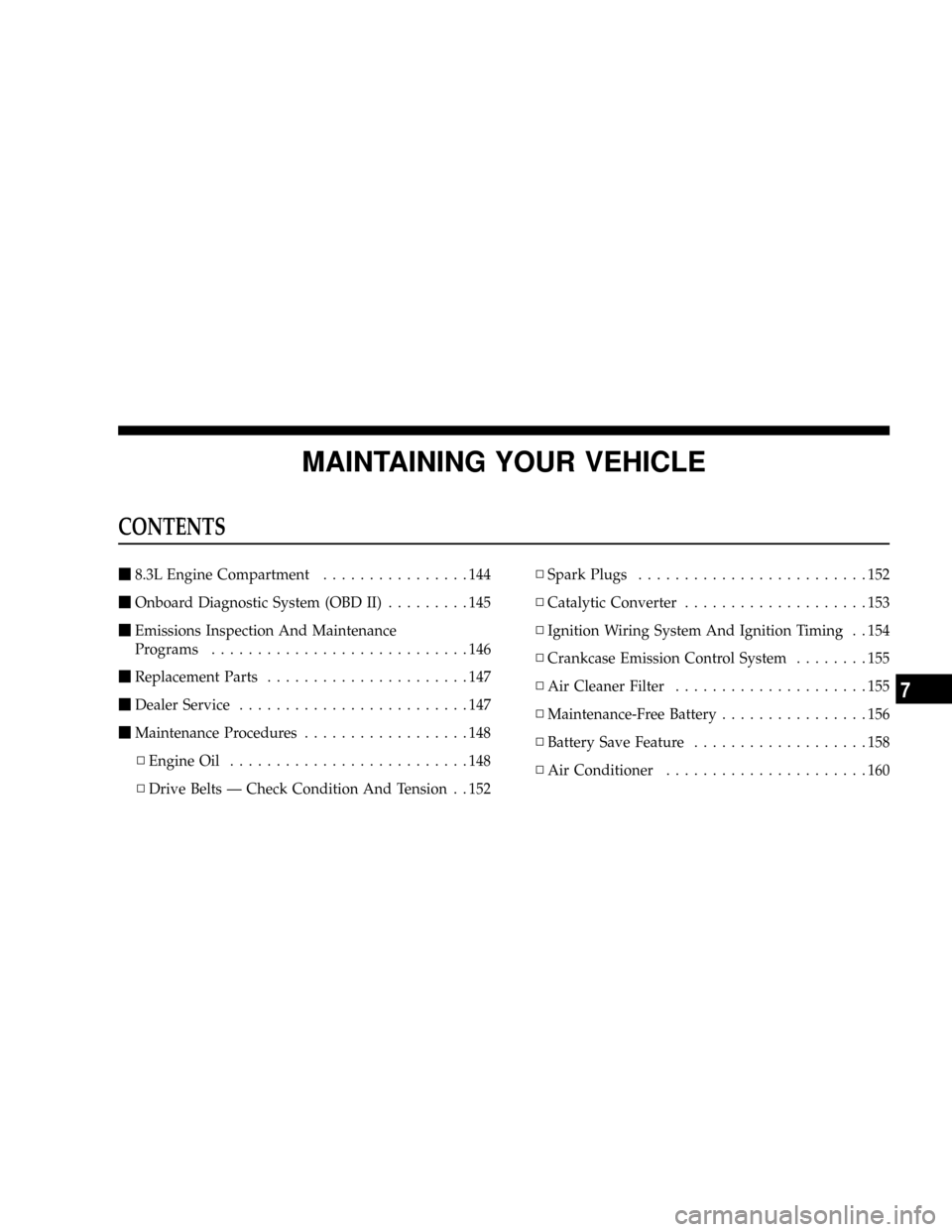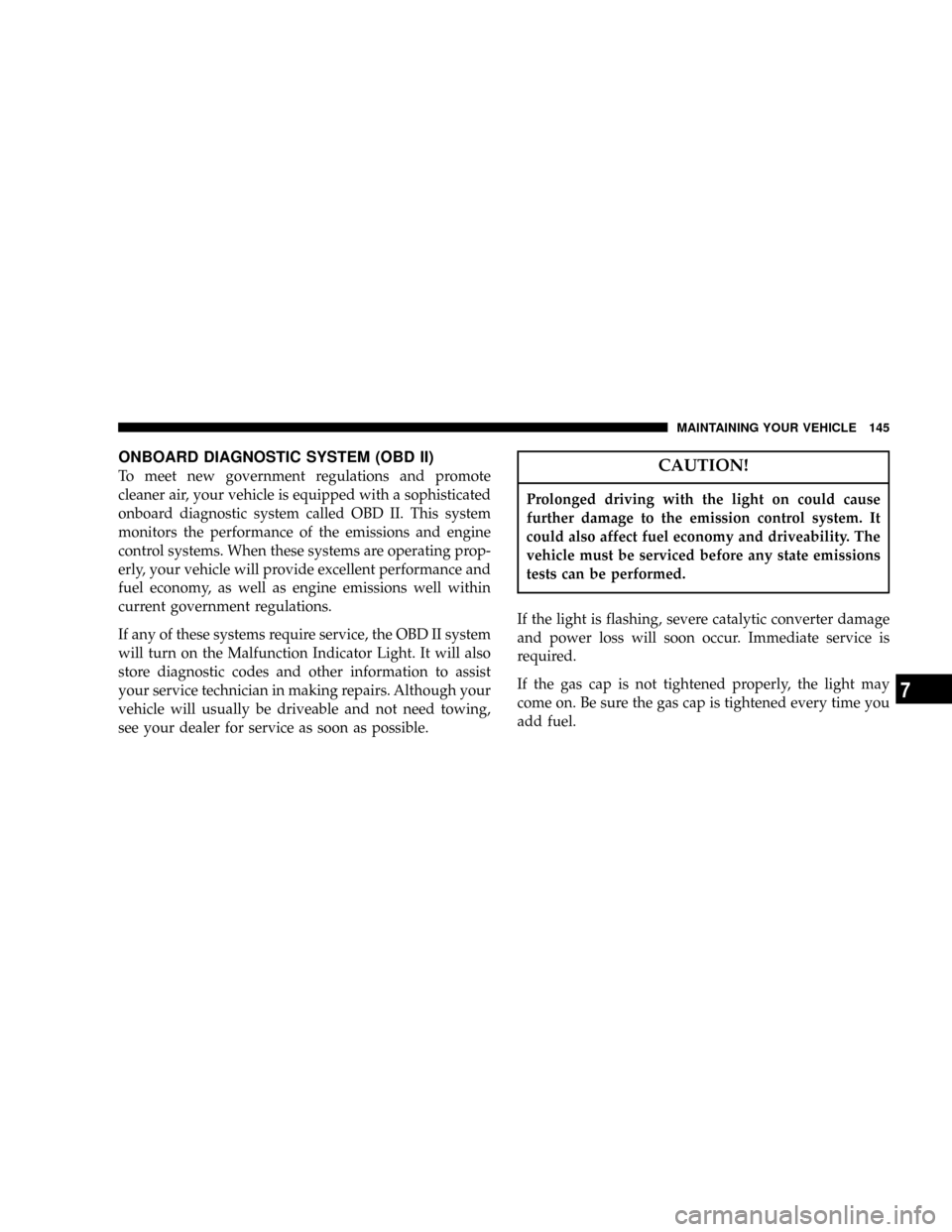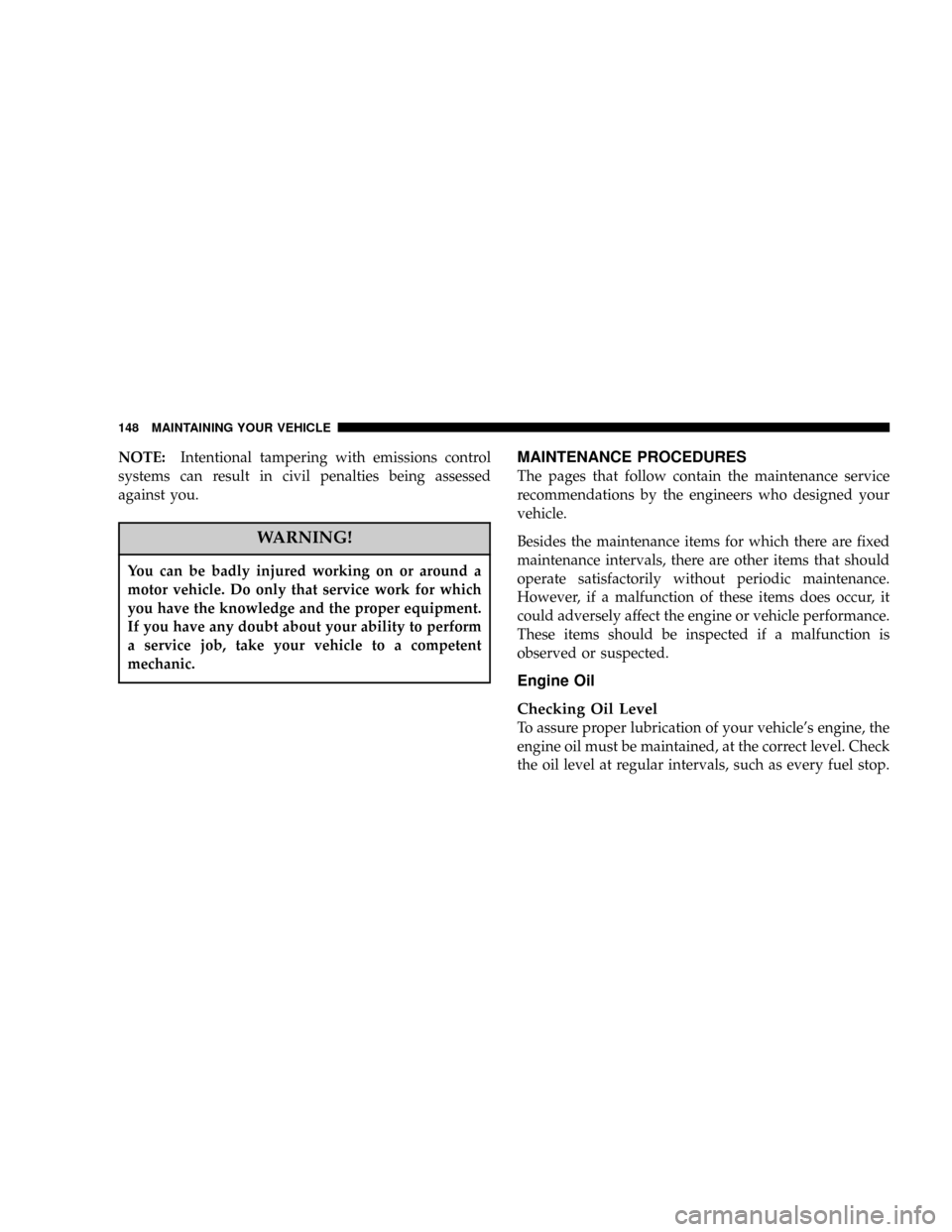DODGE VIPER 2004 ZB / 2.G Owners Manual
Manufacturer: DODGE, Model Year: 2004, Model line: VIPER, Model: DODGE VIPER 2004 ZB / 2.GPages: 236, PDF Size: 4.18 MB
Page 141 of 236

MAINTAINING YOUR VEHICLE
CONTENTS
m8.3L Engine Compartment................144
mOnboard Diagnostic System (OBD II).........145
mEmissions Inspection And Maintenance
Programs............................146
mReplacement Parts......................147
mDealer Service.........................147
mMaintenance Procedures..................148
NEngine Oil..........................148
NDrive Belts Ð Check Condition And Tension . . 152NSpark Plugs.........................152
NCatalytic Converter....................153
NIgnition Wiring System And Ignition Timing . . 154
NCrankcase Emission Control System........155
NAir Cleaner Filter.....................155
NMaintenance-Free Battery................156
NBattery Save Feature...................158
NAir Conditioner......................160
7
Page 142 of 236

NPower Steering (Pump And Reservoir)......161
NBody Lubrication.....................162
NFront And Rear Suspension Ball Joints......162
NSteering Linkage......................163
NBody Mechanism Lubrication.............163
NWindshield Washers...................165
NExhaust System......................165
NCooling System.......................166
NHoses And Vacuum/Vapor Harnesses.......170
NBrake System........................171
NBrake, Power Steering, And Fuel System
Hoses.............................171NBrake And Clutch Fluid.................173
NMaster Cylinder......................174
NHydraulic Clutch.....................175
NTransmission........................175
NRear Axle...........................176
NWheel Bearings.......................177
NAppearance Care.....................177
mFuses Ð Power Distribution Center..........180
mVehicle Storage........................183
mReplacement Bulbs......................186
NInterior Light Bulbs....................186
NExterior Light Bulbs...................186
142 MAINTAINING YOUR VEHICLE
Page 143 of 236

mExterior Light Bulb Service................187
NHeadlight, Parking, Front Park, Turn Signal,
Front Sidemarker And Front Fog Light
Removal...........................187
NHigh Intensity Discharge Headlights (HID) . . . 188
NTail, Tail/Stop, And Marker Lamp Bulb
Replacement.........................189
NBackup And Rear Turn Signal Lamp Bulb
Replacement.........................190
NLicense Plate Light....................193mHeadlight Aiming......................193
NAiming Check.......................194
mFluid Capacities........................195
mRecommended Fluids, Lubricants And Genuine
Parts................................196
NEngine.............................196
NChassis............................197
NBody..............................198
MAINTAINING YOUR VEHICLE 143
7
Page 144 of 236

8.3L ENGINE COMPARTMENT
144 MAINTAINING YOUR VEHICLE
Page 145 of 236

ONBOARD DIAGNOSTIC SYSTEM (OBD II)
To meet new government regulations and promote
cleaner air, your vehicle is equipped with a sophisticated
onboard diagnostic system called OBD II. This system
monitors the performance of the emissions and engine
control systems. When these systems are operating prop-
erly, your vehicle will provide excellent performance and
fuel economy, as well as engine emissions well within
current government regulations.
If any of these systems require service, the OBD II system
will turn on the Malfunction Indicator Light. It will also
store diagnostic codes and other information to assist
your service technician in making repairs. Although your
vehicle will usually be driveable and not need towing,
see your dealer for service as soon as possible.CAUTION!
Prolonged driving with the light on could cause
further damage to the emission control system. It
could also affect fuel economy and driveability. The
vehicle must be serviced before any state emissions
tests can be performed.
If the light is flashing, severe catalytic converter damage
and power loss will soon occur. Immediate service is
required.
If the gas cap is not tightened properly, the light may
come on. Be sure the gas cap is tightened every time you
add fuel.
MAINTAINING YOUR VEHICLE 145
7
Page 146 of 236

EMISSIONS INSPECTION AND MAINTENANCE
PROGRAMS
In some localities, it may be a legal requirement to pass
an inspection of your vehicle's emissions control system.
Failure to pass could prevent vehicle registration.
For states which have an I/M (Inspection and
Maintenance) requirement, this check verifies the
following: the MIL (Malfunction Indicator Lamp)
is functioning and is not on when the engine is running,
and that the OBD (On Board Diagnostic) system is ready
for testing.
Normally, the OBD system will be ready. The OBD
system maynotbe ready if your vehicle was recently
serviced, if you recently had a dead battery, or a battery
replacement. If the OBD system should be determined
not ready for the I/M test, your vehicle may fail the test.Your vehicle has a simple ignition key actuated test
which you can use prior to going to the test station. To
check if your vehicle's OBD system is ready, you must do
the following:
1. Insert your ignition key into the ignition switch.
2. Turn the ignition to the ON position, but do not crank
or start the engine.
3. If you crank or start the engine, you will have to start
this test over.
4. As soon as you turn your key to the ON position, you
will see your MIL symbol come on as part of a normal
bulb check.
5. Approximately 15 seconds later, one of two things will
happen:
a. The MIL will flash for about 10 seconds and then
return to being fully illuminated until you turn off the
146 MAINTAINING YOUR VEHICLE
Page 147 of 236

ignition key or start the engine. This means that your
vehicle's OBD system isnot readyand you shouldnot
proceed to the I/M station.
b. The MIL will not flash at all and will remain fully
illuminated until you turn off the ignition key or start
the engine. This means that your vehicle's OBD system
isreadyand you can proceed to the I/M station.
If your OBD system isnot ready,you should see your
authorized dealer or repair facility. If your vehicle was
recently serviced or had a battery failure or replacement,
you may need to do nothing more than drive your
vehicle as you normally would in order for your OBD
system to update. A recheck with the above test routine
may then indicate that the system is now ready.
Regardless of whether your vehicle's OBD system is
ready or not ready, if the MIL symbol is illuminated
during normal vehicle operation, you should have yourvehicle serviced before going to the I/M station. The I/M
station can fail your vehicle because the MIL symbol is on
with the engine running.
REPLACEMENT PARTS
Use of genuine Mopartparts for normal/scheduled
maintenance and repairs is highly recommended to in-
sure the designed performance. Damage or failures
caused by the use of non-Mopartparts for maintenance
and repairs will not be covered by the manufacturer's
warranty.
DEALER SERVICE
Your dealer has the qualified service personnel, special
tools and equipment to perform all service operations in
an expert manner. Service Manuals are available which
include detailed service information for your vehicle.
Refer to these manuals before attempting any procedure
yourself.
MAINTAINING YOUR VEHICLE 147
7
Page 148 of 236

NOTE:Intentional tampering with emissions control
systems can result in civil penalties being assessed
against you.
WARNING!
You can be badly injured working on or around a
motor vehicle. Do only that service work for which
you have the knowledge and the proper equipment.
If you have any doubt about your ability to perform
a service job, take your vehicle to a competent
mechanic.
MAINTENANCE PROCEDURES
The pages that follow contain the maintenance service
recommendations by the engineers who designed your
vehicle.
Besides the maintenance items for which there are fixed
maintenance intervals, there are other items that should
operate satisfactorily without periodic maintenance.
However, if a malfunction of these items does occur, it
could adversely affect the engine or vehicle performance.
These items should be inspected if a malfunction is
observed or suspected.
Engine Oil
Checking Oil Level
To assure proper lubrication of your vehicle's engine, the
engine oil must be maintained, at the correct level. Check
the oil level at regular intervals, such as every fuel stop.
148 MAINTAINING YOUR VEHICLE
Page 149 of 236

The best time to check the oil level is approximately 5
minutes after a fully warmed up engine is turned off or
before starting the engine after it has sat overnight.
Checking the oil while the vehicle is on level ground also
will improve the accuracy of the oil level readings. Add
oil only when the level is below the SAFE mark.Changing Engine Oil
Road conditions and your kind of driving affects the
interval at which your oil should be changed.
IfANYof the following apply to you, then change your
engine oil every 3,000 miles (5 000 km) or 3 months,
whichever comes first and follow the maintenance rec-
ommendations in ScheduleB.
²Day or night temperatures are below 32ÉF (0ÉC)
²Stop and go driving
²Extensive engine idling
²Driving in dusty conditions
²Short trip driving of less than 10 miles (16.2 km)
²More than 50% of your driving is at sustained high
speeds during hot weather, above 90ÉF (32ÉC)
²Taxi, Police, or delivery service (commercial service)
MAINTAINING YOUR VEHICLE 149
7
Page 150 of 236

²Trailer towing
²Off-road or desert driving
²If equipped for and operating with E±85 (ethanol) fuel
If none of these apply to you, then change your engine oil
every 6,000 miles (10 000 km) or 6 months, whichever
comes first and follow the maintenance recommenda-
tions in ScheduleA.
CAUTION!
Overfilling the crankcase will cause oil aeration and
loss of oil pressure. This could damage your engine.
Engine Oil Selection
For best performance and maximum protection under all
types of operating conditions, select only engine oils that
meet the American Petroleum Institute (API) certification
and SAE viscosity standards.
American Petroleum Institute (API) Engine Oil
Identification Symbol
This symbol on the front of an oil
container means that the oil has
been certified by the American
Petroleum Institute (API) to meet
all the lubrication requirements
specified by the manufacturer.
150 MAINTAINING YOUR VEHICLE